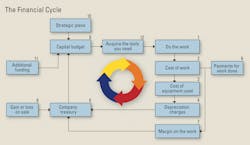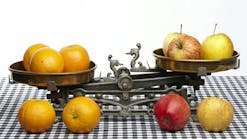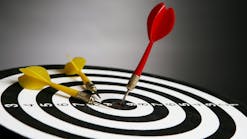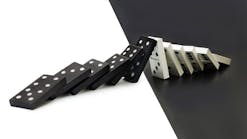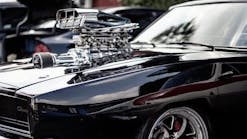Depreciation is a word that has so many meanings that it is almost meaningless. We know that it has something to do with the fact that equipment does not last forever and that we need to write down its value as it ages and is consumed in the production of work. We know that depreciation charges are levied against the equipment account on a monthly basis and that recovering these charges is a real problem, especially when utilization is low. To many, depreciation is an unfortunate and badly understood fact of life.
Let’s discuss three principal meanings for the word “depreciation” and then work our way through the diagram to see exactly how the system works and develop an approach to this important subject.
1) Tax Depreciation. The various, complex and frequently changing tax codes that define the process used to calculate taxable income and tax due allow us to write off certain classes of assets by a stipulated amount over an assumed life. These write offs—or tax depreciation charges—are deductions off our income and serve to reduce our taxable income. All things being equal, they are therefore seen to be “good,” and good tax planning seeks to maximize allowable deductions. The permitted amounts and the various changes stipulated in the tax codes are defined in a process called the modified accelerated cost recovery system: MACRS Tax Depreciation.
2) Accounting Depreciation. This is also known as amortization, an accounting term used to describe the process by which assets used up in the production of income are depreciated to reflect the fact that their value is no longer what it used to be. The rate at which assets are written down in the company’s books and the period over which the write-down occurs are set by company policy. A set of Generally Accepted Accounting Principles (GAAP) established by the Financial Accounting Standards Board (FASB) sets standards and—although the CFO has some latitude—prudent, auditable practice requires that depreciable assets be written down in a conservative consistent manner so that they are neither over- nor under-valued relative to the market.
3) Market Depreciation. This is simply the difference between what you paid for the asset when you bought it and the residual market value received when you sold it at the end of the ownership period.
Both MACRS Tax Depreciation and GAAP Accounting Depreciation are interim estimates that provide for the actual depreciation experienced when the machine is sold and the market tells how much depreciation is actually experienced. The MACRS tax codes and the GAAP principles require that the interim depreciation charges must be trued up relative to market depreciation. This is called a depreciation adjustment and is done by taking the difference between book value (either tax or accounting) at the time of sale and the residual market value actually received when sold (more commonly known as a gain or a loss on sale).
Market depreciation, therefore, has the last word on the subject. Monthly or annual depreciation charges are important and must be made on a regular basis to ensure that the books of account are as correct as possible. They are, however, little more than provisions for the true cost of depreciation that will only be known once the asset is sold.
Depreciation is complex and full of accountant speak. It has to do with the balance sheet and how you report the book value of your assets in the asset register and other books of account. It has to do with the profit-and-loss statement, and how you weave depreciation charges into the equipment rates and equipment costs. It is a complex and emotional topic that has a major impact on fleet management, equipment costing, and company performance. Let’s turn to the diagram and develop a simple, pragmatic understanding of a how depreciation works.
Box 1 shows the beginning of the cycle: We do work, we put completed construction in place. It costs money to do this work (box 2), which includes labor, materials, subcontractors, indirects, and of course, equipment (box 3). The cost of the equipment used to do the work—frequently charged to the jobs as an hourly rate—includes fuel, wear parts, repairs and other costs experienced on an hourly basis. It also covers the cost of licenses, insurances and depreciation charges experienced on a monthly basis.
The first big question is: How do you balance your books when you charge jobs for equipment on an hourly basis and you experience depreciation charges (box 4) on a monthly basis? The answer is utilization. Although simple to say, it’s difficult to achieve. It is difficult to meet the depreciation charges in terms of the GAAP guidelines unless the fleet achieves its utilization targets. Some units, classes or categories will be well-utilized and easily recover their monthly depreciation charges. Others will not. Yet even old, fully depreciated machines do work, and they must contribute to the recovery of depreciation charges.
The depreciation charges recovered from the utilization of the fleet (box 4) flow to the company treasury (box 5), where they are used to write down the value of the equipment assets and help produce the liquidity needed to support the capital budgeting process (box 9).
The treasury has other sources of liquidity, as well. Payments for the work done (box 6) should exceed the cost of doing the work and will produce a margin on the work (box 7). Gain or loss on sale of equipment (box 8) also flows to the treasury.
The capital budget (box 9) draws on the liquidity available in the company treasury. The budget is heavily dependent on the company’s strategic plans (box 10), which define the action required to build capacity and flourish in the marketplace. Decisions are made regarding growth and diversification, and additional outside funding in the form of loans, leases and other acquisition strategies may be required as shown in box 11. The capex budgeting process is critically important. This is where you implement strategic plans by investing in certain classes and categories of equipment. This is where you balance funds between repair, replacement and growth; and this is where you set something aside for the unexpected opportunities that always occur.
Box 12 completes the cycle. The capital budget is used to acquire, repair or rebuild the tools needed to do work in the future. This work will produce the liquidity the treasury needs to survive, grow and flourish in the future; and so the cycle repeats itself. Out of the depreciation charges and the efforts of our current fleet flows the ability to attract additional funding and acquire the tools we need to build work in the future.
It is all pretty simple, but it is also pretty delicately balanced. The cycle can be broken at any point. Know it, understand it, and know the contribution that your decisions make to the long-term survival, success and growth of the business.
